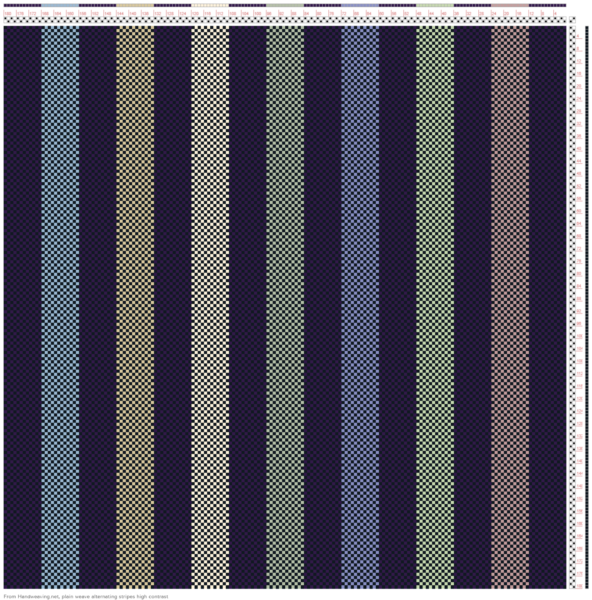Did you know that you can create an infinite number of beautiful handwoven designs with just a few color “recipes”?
When I say “recipe,” I don’t mean rigid formulas, but foundational patterns as flexible as a chef’s recipe for soup stock – a solid, simple base that can be modified in millions of ways to create your own beautiful, unique designs.
Not only that, but these basic patterns can be combined with each other to create endless options.
In the Handweaving Academy, we’ll be offering a series of classes with color recipes, with exercises that show you how to use them and the chance to get inspired by others’ interpretations of those recipes.
Here are some examples of how these color recipes work, drawn from our first month’s classes in the Academy. We’ll launch the Handweaving Academy in December 2022. You can subscribe to the Handweaving Academy mailing list here to get notifications when we launch.
Color Recipe #1: Alternating Light and Dark Stripes
Alternating between light and dark stripes produces a flexible design with a wide range of possibilities. If the stripes are all the same size, you can create simple, elegant designs with just two colors, like this:

Of course, you’re not restricted to just two colors. This design alternates light and dark colors, using lots of different colors for the light color. However, using a consistent rhythm of light alternating with dark gives a sense of unity to the cloth.

The stripes don’t have to be the same size, either. You can get interesting and dynamic looks by changing the size of the stripes, as in the optical-illusion draft below. The possibilities are endless!

Color Recipe #2: The light-to-dark gradient
Another appealing color recipe is to use a light-to-dark gradient, gradually changing the darkness of your stripes as you go. Here is an example of warp stripes in a simple gradient, going from dark brown to light brown and back again:

Of course, you can also use multiple colors and/or stripes that are not the same width. Here is a light-to-dark gradient “recipe” adaptation that uses blues and browns, with stripes of different sizes:

As you can see, the basic pattern of the light-to-dark gradient can be used in many forms to create beautiful designs.
Mixing it up: Combining Recipes
While you can create an infinite number of beautiful designs with just a single color recipe, you can also combine recipes for even more gorgeous, original results. Here are just a few of the things that can happen when you combine alternating light and dark stripes with light-to-dark gradients in a design:
Alternating double gradients
In the draft below, there are two light-to-dark color gradients that alternate with each other: a dark blue to light blue gradient that goes left to right, and a dark brown to light brown gradient that goes right to left. The result is a draft that alternates light and dark AND contains light to dark gradients…beautiful!

Of course, there’s no need for the stripes to be the same size. Here’s an intriguing version of the draft with different size stripes:

There are plenty of other combinations of these two “recipes”. Here’s one more, where the alternating stripes in a series form a value gradation:

Color and design “recipes” come in all types. These recipes are for patterns of light and dark stripes – but you can also have recipes for color mixes, stripe widths (Fibonacci stripes are just one example!), and many more.
They can also be combined with more complex structures than plain weave. We’ll be covering many design recipes in the Handweaving Academy – and we’ll be launching that very soon!

Great, thank you for all this info. Cannot wait for your Academy web site to be up and running so I can sign up and learn more.
I am looking forward to weaving again with you and Janet. I am moving to NC by the end of the year or early Jan. My yarn is in NC and the loom is in NY with me. I will figure it out some how.
Hi Tien
I whish you and Janet well in your new adventure.
It's nice to have all the resorces just a klick away and i would use these definitelly.
But i can't imagine that i would attend classes on a recular basis.
Happy Weaving Rosemarie